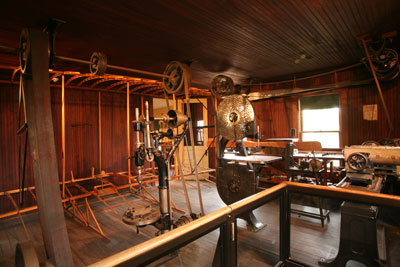|
By the end of the 19th century technological miracles were commonplace. Railroad trains routinely traveled a-mile-a-minute. Electric lights could turn night into day. Voices traveled over wires. Pictures could be set into motion. Lighter-than-air balloons and dirigibles even offered access to the sky. But the age-old dream of flying with wings like birds still seemed like a fantasy. In a simple bicycle shop now located in Greenfield Village, two brothers from Dayton, Ohio, turned the fantasy of heavier-than-air flight into reality.
The Wright Cycle Shop building was actually the sixth and last of a series of rented structures out of which Wilbur and Orville ran their bicycle business. Here they serviced bikes, sold new and used ones, and even manufactured bicycles under the brand names Van Cleve and St. Clair. The income from this shop financed their aviation experiments.
But the Wright Cycle Shop was more than a place of business. It was. . .
. . . an aircraft factory. Between 1900 and 1908 the Wrights built all their aircraft—experimental gliders, the first powered planes, and the airplanes in which they gave their first public flying demonstrations—in this shop.
. . . the world’s most important aeronautical laboratory. When their 1901 glider failed to perform as they expected the brothers began to doubt the validity of some of the information they used in designing it. The Wrights were using a table of lift and drag coefficients compiled by German glider pioneer Otto Lilienthal. The accepted formula for calculating the lift produced by a wing used a constant whose value had been experimentally derived. The brothers now had doubts about both. In late 1901 they devised a wind tunnel and innovative measuring instruments to test various wing shapes, and developed new values to use in the equations. Armed with this revised information, the Wrights designed and built a highly successful 1902 glider. The lessons learned in the wind tunnel were also useful when it came time to design propellers for their powered aircraft.
. . . an aircraft engine factory. With invaluable assistance from their mechanic, Charlie Taylor, Wilbur and Orville designed and built a series of relatively simple but lightweight internal combustion engines that powered their 1903, 1904, 1905, and 1908 aircraft.
In 1936 Henry Ford purchased the cycle shop and the Wright family home and moved them from Dayton to Greenfield Village. Ford admired the Wrights as self-made men, like himself. The Wright shop fit perfectly with other Greenfield Village buildings associated with men like inventor Thomas Edison, pioneering plant breeder Luther Burbank, compiler of the first dictionary of American English Noah Webster, and influential educator William Holmes McGuffey. Such buildings made the point that significant innovations can come from virtually anyplace where curiosity, talent, and persistence flourish.
Today’s visitors are struck by the simplicity of the Wright shop. There is a small showroom and counter where the brothers dealt with customers, and a small office where they did the Wright Cycle Company paperwork. Behind the public rooms are the workrooms, outfitted with hand tools for building and repairing bicycles. Behind them is a wooden addition, equipped with standard, readily available power tools: a lathe, drill press, and band saw.
 |
The Wrights’ drill press, band saw, and lathe (far right) occupy the back part of the cycle shop. Behind them is a replica of part of the framing for the 1903 Flyer. Wilbur and Orville built the components for their airplanes in the shop—but the planes themselves were too big to fully assemble there. Instead, the parts were shipped out as “kits” that the brothers put together wherever they were doing their flying. THF.74904
|
But the very simplicity of the place accents the enormity of Wilbur and Orville’s accomplishment. Visitors to the shop often hear the noise of jet aircraft in the flight path for Detroit Metro Airport. Standing in the shop, with continent-spanning aircraft flying overhead, one is hit by the realization that history happened here, that the world changed here.
It's a feeling both thrilling and humbling.
| |
-- Bob Casey, Senior Curator of Transportation |
|

